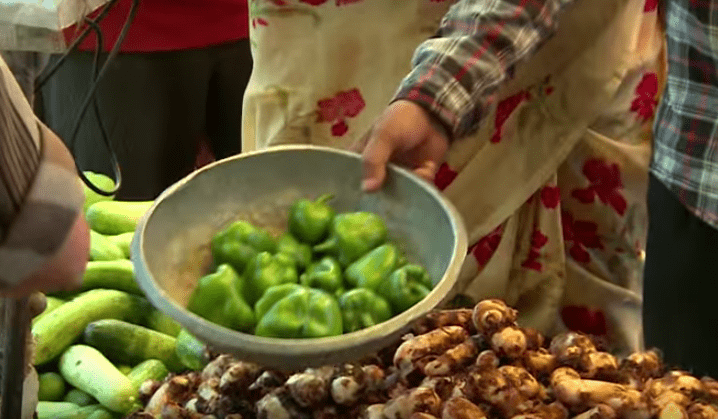Lesson plan developed for http://hindistartalk.lrc.columbia.edu/ by Rosanne Zeppieri and Rajni Bhargava; language notes by Rakesh Ranjan.
 Age Range of Learners: 8-12 years
Age Range of Learners: 8-12 years
Targeted Performance Level: Novice Mid/High
Time: 90 minutes
http://hindistartalk.lrc.columbia.edu/lesson/vegetable-market/
Objectives: Students will be able to:
- Greet people in a polite way.
- Answer simple questions about the foods I like at the market.
- Ask simple questions about the food items found at a typical outdoor market in India (price, quantity). Describe the color and size of some fruits and vegetables.
- Make a purchase at a market. I can understand the names of fruits and vegetables found at an outdoor market.
Language Targets:
Names of fruits and vegetables typically found at an outdoor market in India.
Vegetables:
|
Taste:
|
Fruits:
|
Descriptive vocabulary related to color, size, and taste of a few fruits and vegetables:
Colors:
|
Shape and Texture
|
Shape and Texture
|
Expressions describing preferences (I like, I do not like, I want):
- I like X – mujhe X pasand hai
- I do not like X -mujhe X nahiiN pasand hai/ mujhe X naapasand hai
- I want X –maiN X chaahtaa/chaahtii huuN
Currency: (Indian) Rupee, paisaa (m) – rupayaa, paisaa
Expressions of quantity:
- Quarter kg- ek paaw
- Half a kg- aadhaa kilo
- Three quarters- paon/paunaa
- One kg- ek kilo
- One and a quarter kg-sawaa kilo
- One and half kg- DeRh kilo
- Two and three quarters kg- paone two kilo
- Two kg- do kilo
- Two and half kg- Dhaaii kilo
Simple expressions used when making purchases at a market:
- How much is…? – … kitne kaa hai?/
- I would like to buy…?maiN …kharidnaa chahtaa/chahtii huuN
- That’s too much. – vah bahut hai!
- I’ll pay… maiN …paise duuNgaa/duuNgii
Materials:
- Cooking utensils, cooking gear, recipes in Hindi http://ajmeronlinestore.com/prodCat.php?pcId=Vegetables (Online site for selling fruits and vegetables)
- T-Chart http://hindistartalk.lrc.columbia.edu/lesson/rajawat-family-vegetable-market/ (Hindi Module)
Performance Assessment:
Students will “visit” a typical market in India. They will comment on the foods and make purchases by bargaining for a reasonable price. Using a Venn diagram, they will then work in pairs to compare an American outdoor market with one found in India.
Opening Activity: Teacher plays the video clip entitled, “Rajawat Family – Vegetable Market”(Module 1), to set the context for the lesson and to introduce the names and descriptions of various vegetables. The teacher will tell a “story” about his/her visit to a market with a focus on the names and descriptions of the vegetables and his/her preferences.
Activity 2: The teacher distributes and 8×10 sheet of paper with small pictures of the targeted vocabulary. Students tear the sheet into individual pictures to use during listening tasks: Working in pairs, students play the flyswatter game (using their fingers as the flyswatter) to begin to internalize the new vocabulary. The teacher calls out the words, the students point to the corresponding picture. One student plays the role of the teacher and the other points out the correct picture. The teacher then describes the vegetable and the students point to the corresponding pictures. As the teacher tells the story of his/her visit to the market, the students hold up the picture of the item as they hear its name.
Using the small pictures of the vegetables, students work in pairs to categorize them according to color, size, their preferences, or other categories of their choice. They explain their categories to another pair. The teacher debriefs the task using the Four
Corners strategy (http://wvde.state.wv.us/teach21/FourCorners.html)
Activity 3: Teacher distributes Indian currency (fake Rupees) of different denominations. He/She conducts an oral review of the numbers using the currency. He/She shows pictures of various vegetables and ask students to decide on the cost per gram, per kilo, etc.
Activity 4: Students “visit” an online Indian market to “purchase” items using the Rupees they have received from the teacher. They work in pairs to talk about what they like and what they want to buy. They share their purchases with another pair of students. The teacher debriefs the task with the whole class asking students’ preferences, the quantity they bought, and the money spent. http://ajmeronlinestore.com/prodCat.php?pcId=Vegetables
Activity 5: Using simple expressions, the teacher demonstrates the art of bargaining at a market in India. He/She works with the class to practice the expressions used when bargaining by taking the role of the seller and asking students to take the role of the buyer. Next, she switches roles with the students and continues practicing the exchange. Students work in pairs to practice a similar role play taking turns as sellers and buyers.
Activity 6: Teacher sets up a market in the classroom. Half the students play the role of the sellers, the other half the buyers. The buyers have a specific amount of money to spend. They circulate to buy food, bargain for a good price, and complete their transactions. Students switch roles and conduct the same role play.
Closure: Distribute one sticky note to each learner and ask him or her to record and then display the most important thing learned that day.
